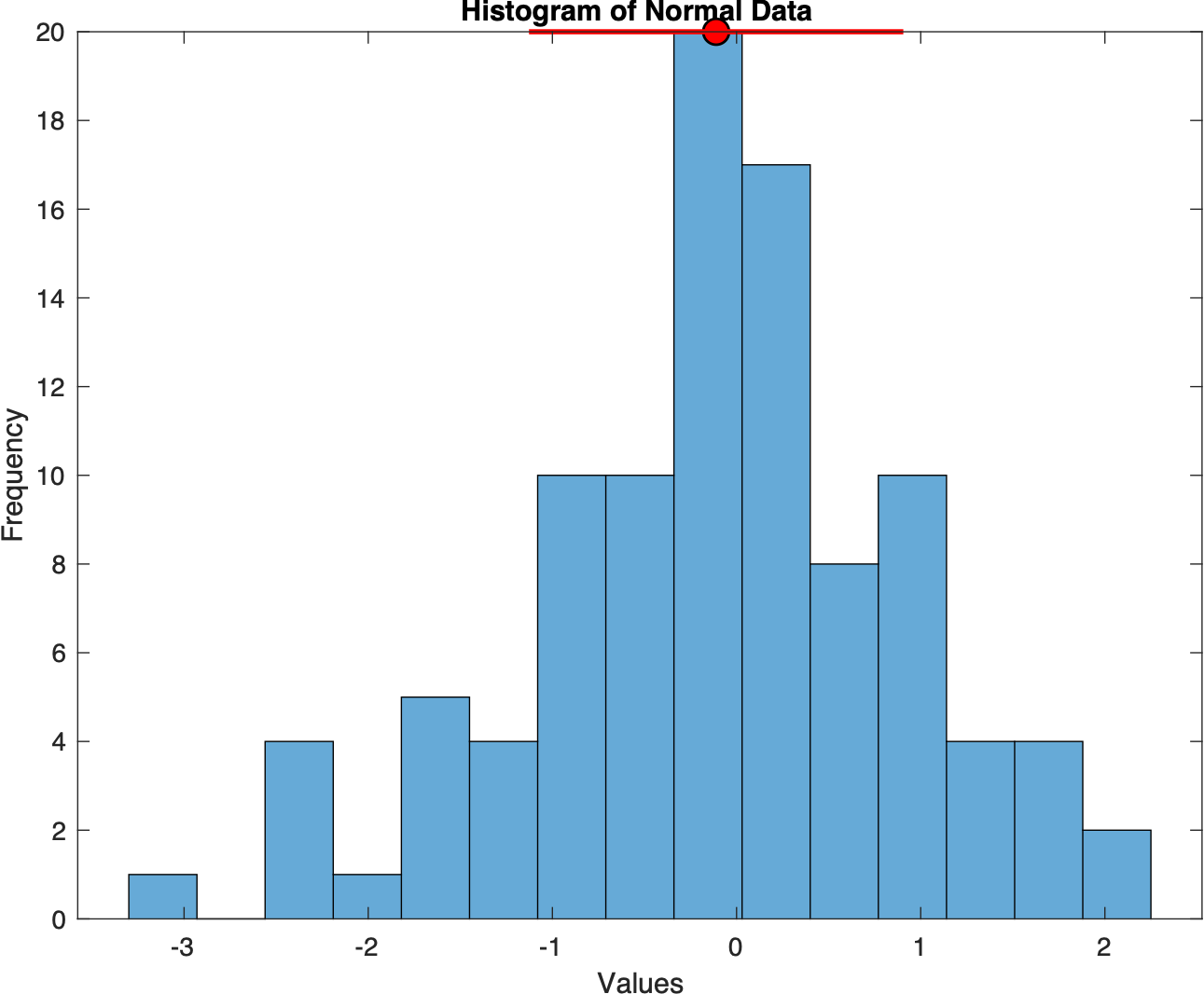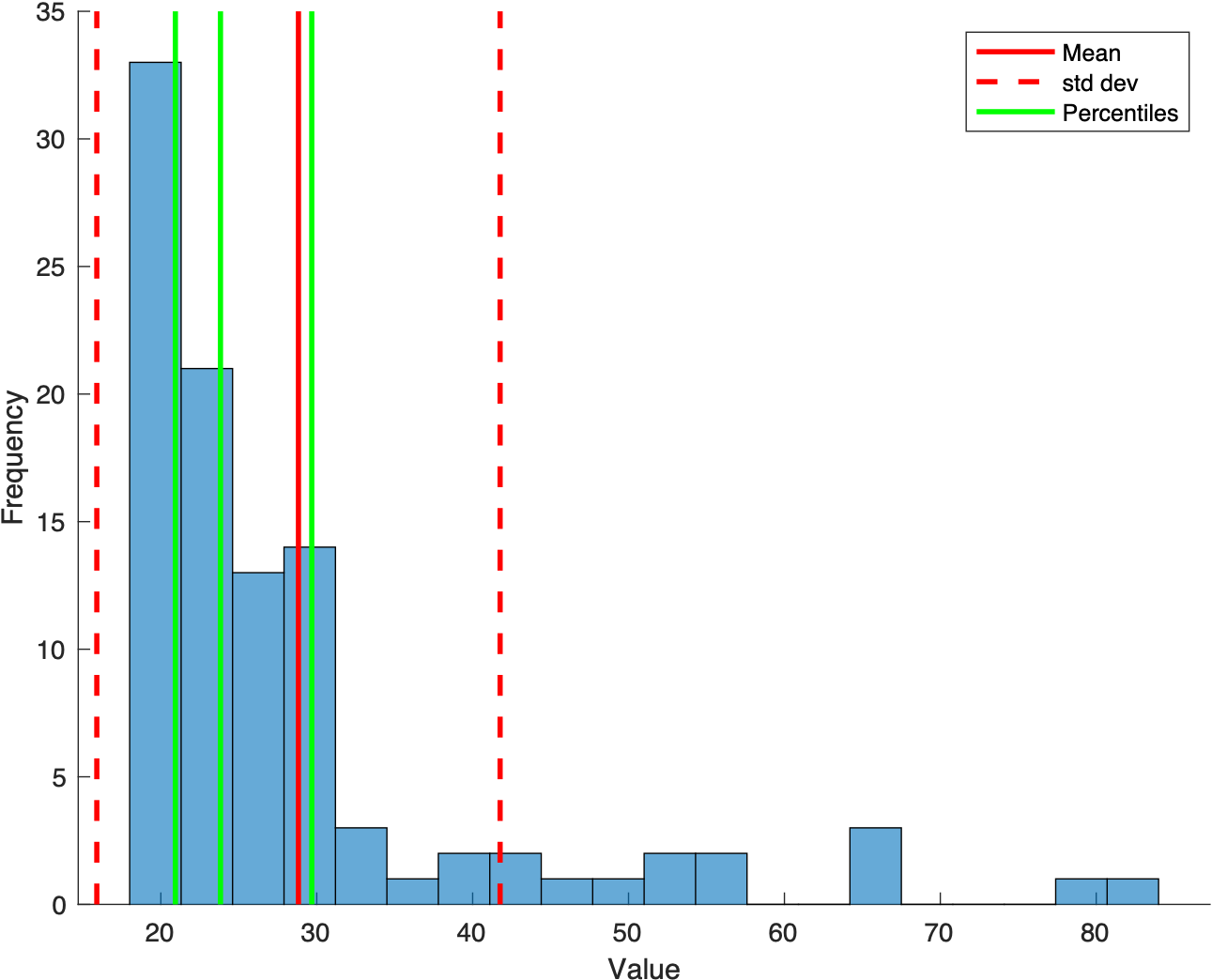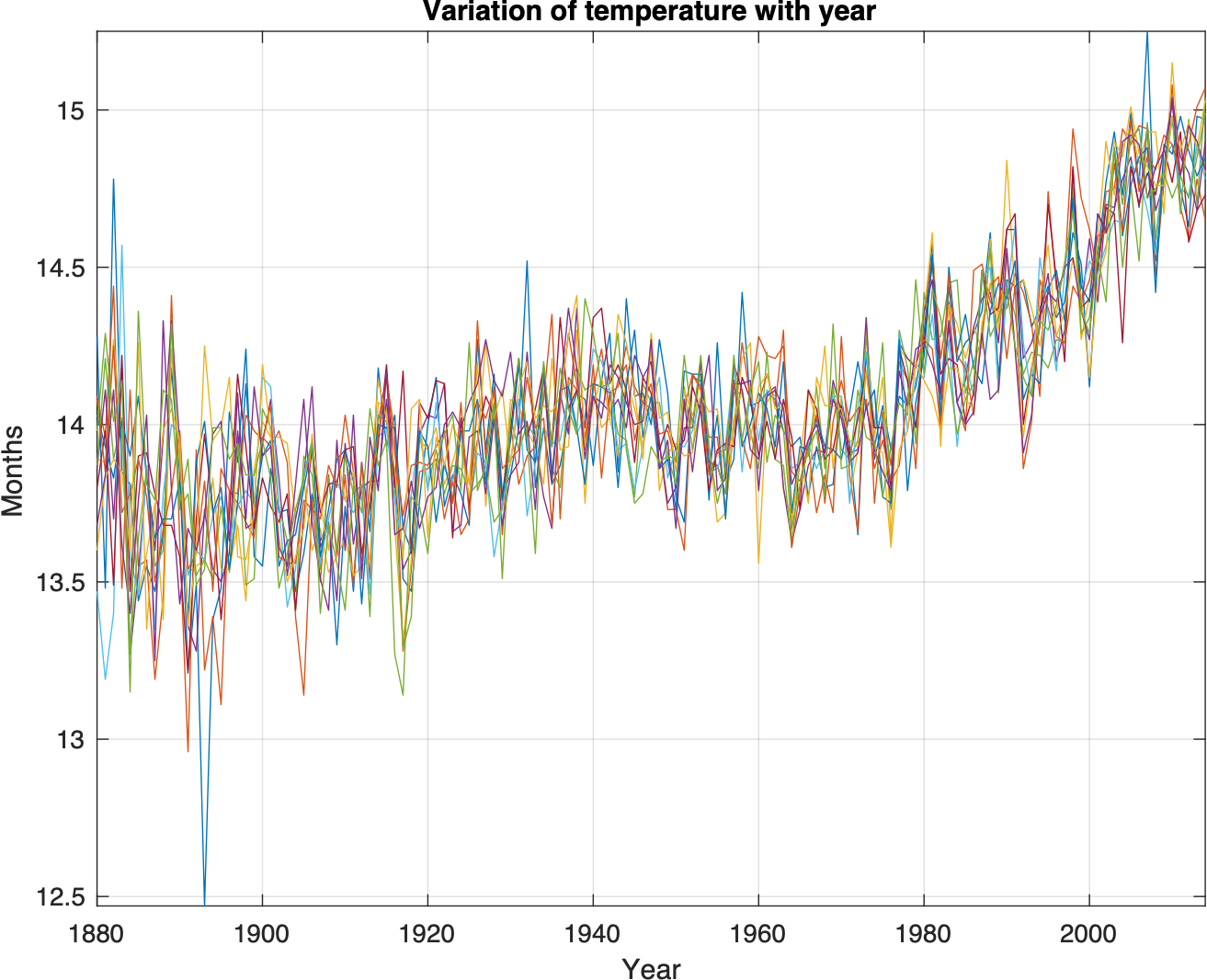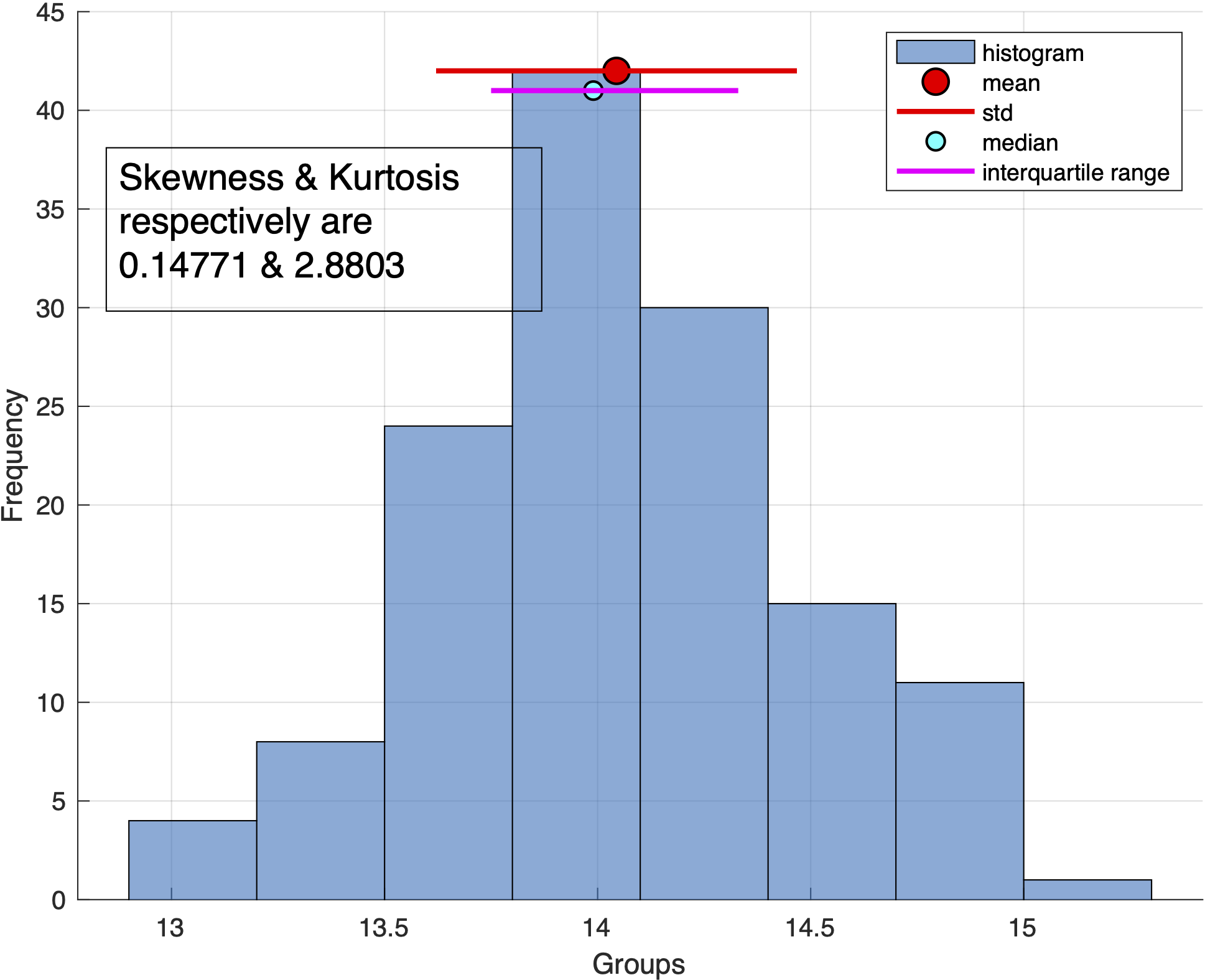Easy Statistical Analysis using the tools of MATLAB (codes included)
Visualize the statistics of the data using MATLAB: mean, median, std, interquartile range, skewness, kurtosis, t-statistic, degrees of freedom
“Technological innovations such as reconnaissance satellites are capable of spewing out data in volumes that defy conventional methods of interpretation. In the words of John Griffiths, “we must be able to digest the mass before it becomes a mess.” Only computer implemented mathematical and statistical tech- niques are powerful enough and fast enough to perform the task.” - J.C. Davis
Similar posts
Analyzing random (normal and non-normal) data to perform basic statistical analysis
- Generate histograms
- plot mean and standard deviation
- compute and plot percentiles


%% Analysing random data to learn statistical skills
clear; close all; clc;
%% Normal Data
figure(1)
dataNormal=randn(100,1);
h1=histogram(dataNormal,15);
xlabel('Values'), ylabel('Frequency')
title('Histogram of Normal Data')
hold on
mu=mean(dataNormal);
sd=std(dataNormal);
binmax = max(h1.Values); %finding the maximum bin height
plot(mu,binmax,'ko','markerfacecolor','r', 'markersize',10); %plotting the location of mean
plot([mu-sd, mu+sd],[binmax, binmax], '-r', 'linewidth', 2); %plotting the 1 std
saveas(gcf,"normal_data_stats",'pdf')
%% Non-Normal Data
% generate some fake data
x = (randn(1,100).^2)*10 + 20;
% compute some simple data summary metrics
mn = mean(x); % compute mean
sd = std(x); % compute standard deviation
ptiles = prctile(x,[25 50 75]); % compute percentiles (median and central 68%)
% make a figure
figure;
hold on;
histogram(x,20); % plot a histogram using twenty bins
ax = axis; % get the current axis bounds
% plot lines showing mean and +/- 1 std dev
h1 = plot([mn mn], ax(3:4),'r-','LineWidth',2);
h2 = plot([mn-sd mn-sd],ax(3:4),'r--','LineWidth',2);
h3 = plot([mn+sd mn+sd],ax(3:4),'r--','LineWidth',2);
% plot lines showing percentiles
h4 = [];
for p=1:length(ptiles)
h4(p) = plot(repmat(ptiles(p),[1 2]),ax(3:4),'g-','LineWidth',2);
end
legend([h1 h2 h4(1)],{'Mean' 'std dev' 'Percentiles'});
xlabel('Value');
ylabel('Frequency');
saveas(gcf,"non_normal_data_stats",'pdf')
Global monthly temperature data
- Plot temperature data vs year
- compute basic statistics: mean, median, std, interquartile range, skewness, kurtosis
- plot histogram and statistics on it


clear; close all; clc;
load temp_month
%% Making a matrix of data
p=[Jan,Feb,Mar,Apr,May,Jun,Jul,Aug,Sep,Oct,Nov,Dec];
pstring={'Jan','Feb','Mar','Apr','May','Jun','Jul','Aug','Sep','Oct','Nov','Dec'};
[row, col]=size(p);
%% Plotting the data vs year
figure
for i=1:col
plot(Year,p(:,i))
grid on
hold on
end
title('Variation of Months with Year')
xlabel('Year'), ylabel('Months')
axis tight
saveas(gcf,"dataYear",'pdf')
%% Statistical Analysis
for i=1:col
dd=p(:,i);
mu(i)=mean(dd); %mean
sd(i)=std(dd); %standard deviation
med(i)=median(dd); %median
x = min(dd):0.01:max(dd);
ddsorted = sort(dd,'ascend'); %interquartile range
e25=ceil(25/100*length(dd)); e75=ceil(75/100*length(dd));
iqr_dd = ddsorted([e25, e75]);
skew_dd=skewness(dd);
kurt_dd = kurtosis(dd);
%Plotting Figure
figure
% subplot(2,2,[1 2])
xlabel('Groups'), ylabel('Frequency'),grid on
annotation('textbox',...
[0.15 0.65 0.3 0.15],...
'String',{'Skewness & Kurtosis respectively are ',[num2str(skew_dd),' & ', num2str(kurt_dd)]},...
'FontSize',14,...
'FontName','Arial')
hold on
h1=histogram(dd,'BinMethod','auto');
binmax1(i) = max(h1.Values); %finding the maximum bin height
plot(mu(i),binmax1(i),'ko','markerfacecolor','r', 'markersize',10); %plotting the location of mean
plot([mu(i)-sd(i), mu(i)+sd(i)],[binmax1(i), binmax1(i)], '-r', 'linewidth', 2); %plotting the 1 std
plot(med(i),binmax1(i)-1,'ko','markerfacecolor','c', 'markersize',7)
plot(iqr_dd,[binmax1(i)-1, binmax1(i)-1], '-m', 'linewidth',2);
legend('histogram','mean','std','median','interquartile range')
saveas(gcf,sprintf("hist_Month%s",pstring{i}),'pdf')
end
T-statistic
The uncertainty in the estimation of the population statistics can be accounted for by using a probability distribution that has a wider “spread” than the normal distribution. One such probability distribution is called the t distribution (similar to the normal distribution). It is dependent upon the size of the sample taken. When the number of observations in the sample is infinite, the t distribution and the normal distribution are identical.
The t-statistic is the ratio of the departure of the estimated value of a parameter from its hypothesized value to its standard error. t-tests are useful for establishing the likelihood that a given sample could be a member of a population with specified characteristics, or for testing hypotheses about the equivalency of two samples.
For a dataset with samples randomly collected from a normal population, the t-statistic may be computed by
\begin{equation} \label{eq:tstatistic} \begin{split} t = \frac{\bar{X}-\mu_0}{s/\sqrt{n}} \end{split} \end{equation}
where,
\(\bar{X}\): mean of the sample
\(\mu_0\): hypothetical mean of population
\(n\): number of obervations
\(s\): standard deviation of observations
Example
Let us taken the example from Davis and Simpson, 1986 for the porosity measurements.
| Sample number | Porosity (%) |
|---|---|
| 01 | 13 |
| 02 | 17 |
| 03 | 15 |
| 04 | 23 |
| 05 | 27 |
| 06 | 29 |
| 07 | 18 |
| 08 | 27 |
| 09 | 20 |
| 10 | 24 |
We wish to test that about samples came from the population having porosity of more than 18%.
Hypothesis test
Here, our null hypothesis is:
\begin{equation} \label{eq:nullhyp} \begin{split} H_0: \mu_1 \leq \mu_0 \end{split} \end{equation}
Alternative hypothesis:
\begin{equation} \label{eq:althyp} \begin{split} H_1: \mu_1 \geq \mu_0 \end{split} \end{equation}
In this test, we assume the mean, \(\mu_0\), \(s\) is estimated. For the above dataset of 10 samples, the degrees of freedom is 9.
We reject the null hypothesis only if the mean porosity significantly exceeds 18%. If we wish to test this hypothesis with the probability of rejecting it when it is true only one is twenty times (\(\alpha = 0.05\)), the computed value of t must exceed 1.833 for a one-tailed test. See here for the table of the Stduent’s t distribution with \(\nu\) degrees of freedom.
The obtained value of 1.89 exceeds the critical value of t for nine degrees of freedom and 5% level of significance and hence lies in the critical region or region of rejection. Hence, we can reject the null hypothesis, leaving us with the alternative hypothesis that the porosity of the population from which the dataset was sampled is greater than 18%. Note that if the null hypothesis were accepted, we could only say that there is nothing in the sample to suggest that the population means is greater than 18%.
Computing t-statistic using MATLAB
clear; close all; clc;
% generate some fake data
data1=randn(100,1);
data2=(randn(150,1).^2)*10 + 20;
mu_x=mean(data1)
mu_y=mean(data2)
%t-statistic
[h,p,ci,stats] = ttest2(data1,data2,0.05,'both','unequal')
mu_x = -0.0727
mu_y = 29.8633
h = 1
p = 7.6969e-54
ci =
-32.3794
-27.4925
stats =
struct with fields:
tstat: -24.2062
df: 150.9778
sd: [2×1 double]
References:
- Lectures on Statistics and Data Analysis in MATLAB
- Davis, J. C., & Sampson, R. J. (1986). Statistics and data analysis in geology (Vol. 646). Wiley New York.
- Wikipedia: t-statistic
- Davis, J., & Sampson, R. (1986). Statistics and data analysis in geology. Retrieved from https://www.academia.edu/download/6413890/clarifyeq4-81.pdf
Disclaimer of liability
The information provided by the Earth Inversion is made available for educational purposes only.
Whilst we endeavor to keep the information up-to-date and correct. Earth Inversion makes no representations or warranties of any kind, express or implied about the completeness, accuracy, reliability, suitability or availability with respect to the website or the information, products, services or related graphics content on the website for any purpose.
UNDER NO CIRCUMSTANCE SHALL WE HAVE ANY LIABILITY TO YOU FOR ANY LOSS OR DAMAGE OF ANY KIND INCURRED AS A RESULT OF THE USE OF THE SITE OR RELIANCE ON ANY INFORMATION PROVIDED ON THE SITE. ANY RELIANCE YOU PLACED ON SUCH MATERIAL IS THEREFORE STRICTLY AT YOUR OWN RISK.


Leave a comment